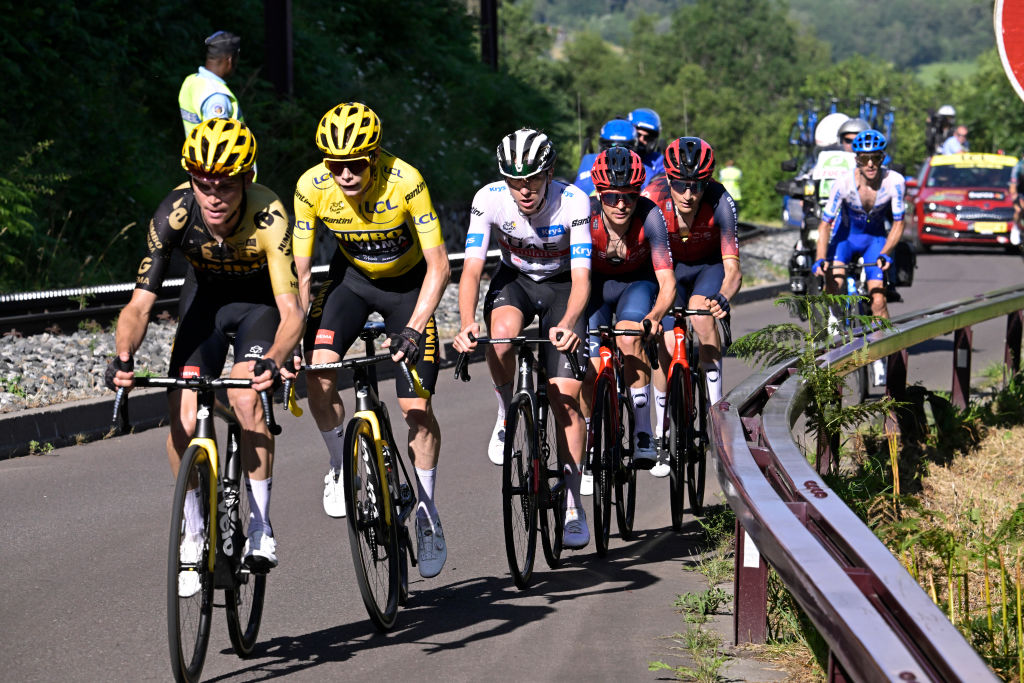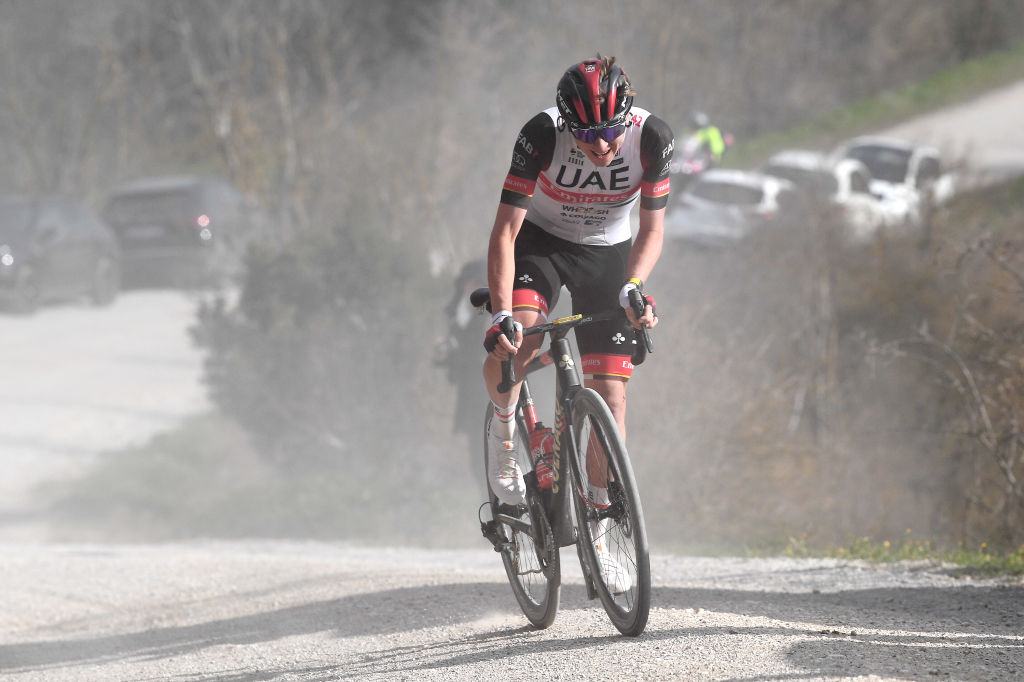There's no way to Jumbo-proof the Tour de France - 2024 route analysis
Evenepoel, Pogačar and Roglič have reason to smile, but so does Vingegaard

“There’s something for everyone,” race director Christian Prudhomme said after unveiling the route of the 2024 Tour de France, and it was hard to disagree. The fast men would undoubtedly prefer some more obvious sprint opportunities, but when the lights went up in the Palais des Congrès, each of the four overall favourites could point to elements in his favour.
Remco Evenepoel’s imminent Tour debut was always likely to inspire route designer Thierry Gouvenou to ladle a generous dollop of time trial kilometres onto the route after a few years of parsimony, and so it proved.
It was already established that the race would finish with a 34km time trial in Nice, and on Wednesday, it was revealed that the Tour would also include a 25km test to Gevrey-Chambertin on stage 7. It makes for a total of 59km against the watch, almost three times last year’s historic low.
In Evenepoel’s brief Grand Tour career, he has developed the useful habit of making a big impact in time trials a week or so into the race. One imagines that ASO’s dream scenario would be for Evenepoel to lay down a marker and snatch yellow here, forcing Tadej Pogačar, Jonas Vingegaard and Primož Roglič onto the offensive to take it off him.
“The time trials are in Remco's favour, but I think our friend who won this year [Vingegaard – ed.] will also enjoy that,” was Soudal-QuickStep manager Patrick Lefevere’s snap assessment of the parcours.
Evenepoel might be helped, too, by the way the mountain stages are distributed across the race. Although this Tour features some 52,000m of total climbing, the peloton will never face more than two consecutive days in the high mountains. A similar configuration tallied neatly with Evenepoel’s strengths in the 2022 Vuelta a España.
Newly installed at Bora-Hansgrohe, Primož Roglič will, like Evenepoel, appreciate the increased dose of time-trialling kilometres and, based on his own penchant for fast starts in Grand Tours, he will relish the idea of tackling the Col du Galibier so early, on stage 4. There perhaps aren’t quite as many punchy finales as the Roglič would like, but the terrain at Le Lioran on stage 11 and Superdévoluy ought to be to his liking.
Get The Leadout Newsletter
The latest race content, interviews, features, reviews and expert buying guides, direct to your inbox!
The final time trial in Nice, meanwhile, will inevitably conjure up comparisons with LeMond and Fignon’s duel on the Champs-Élysées in 1989, and it will also evoke the heartache Roglič endured at La Planche des Belles Filles in 2020.
But that memory will surely serve to inspire Roglič rather than to inhibit him. After all, he emphatically banished any notion of a complex about late time trials by winning the Giro d’Italia triumph at the last atop Monte Lussari last May. The 34-year-old will view the Nice finale – and, indeed, this entire route – as a clear opportunity to close the circle.
Pogačar
Given that Tadej Pogačar is arguably the most complete bike rider since Eddy Merckx, it’s hard to imagine a Tour route that wouldn’t meet with the Slovenian’s broad approval. He opted against attending the presentation, but he issued a statement expressing his satisfaction both with the tough start and the demanding finish to a course he deemed to be “full of promise.”
Pogačar reckons the opening phase of the 2024 race is even tougher than last July, when he and Vingegaard already found themselves trading heavy blows during the race’s early passage through the Pyrenees. He also expressed enthusiasm for the arduous final three days on his training roads, which features summit finishes at Isola 2000 and the Col de la Couillole ahead of the rolling test from his home in Monaco to Nice.
Curiously, Pogačar made no mention of the day that seems to lend itself to him above all others, namely stage 9 around Troyes, which features some 32km of gravel across 14 sectors. With Strade Bianche on his palmarès – not to mention his ease amid the rough and tumble of the Flemish Classics – Pogačar will surely see this stage as an opportunity to put his key rivals in difficulty.
Evenepoel, infamously, endured a wretched day on the dirt roads of Montalcino on the 2021 Giro, and he might approach this stage with a degree of trepidation. Above all, Pogačar will hope to test Vingegaard on this terrain, given that the Dane has generally had his number in the high mountains for the past two years, Cauterets notwithstanding.
Jumbo-Visma manager Richard Plugge was certainly not enamoured with the excursion across the gravel tracks of the Champagne region when he spoke with Wielerflits immediately after the presentation.
“That didn't have to be included on the course for me,” Plugge complained. “It doesn't make any sense. I don't understand why they are doing that again. You introduce the bad luck element into the race too much. Gravel can have such an impact on the result, purely through bad luck.”

Vingegaard
Yet Vingegaard, for his part, was typically understated in his reaction to the route. Then again, the Dane has appeared utterly unfazed by everything the Tour has thrown at him since he unexpectedly stepped into the role of team leader after Roglič’s early abandon in 2021. When he won the Tour in 2022 and 2023, Vingegaard proved superior to Pogačar both in the high mountains and against the watch, and he was also backed by the strongest team – by far – in the race.
Jumbo-Visma’s dominance these past two years has been absolute and, even allowing for Roglič’s departure, there is little reason to believe that dynamic will have changed significantly by next July, particularly with Vuelta winner Sepp Kuss on hand to serve as Vingegaard’s foil, and Wout van Aert on duty as an all-terrain deluxe domestique.
Last summer, Vingegaard and Jumbo-Visma repeatedly suggested they had a plan to ‘break’ Pogačar. It sounded almost like bravado when Pogačar was chipping away at the Dane’s advantage in the second week, but it turned out they weren’t bluffing. Vingegaard put 1:38 into Pogačar in the space of just 22.4km in the stage 16 time trial, and he proceeded to offer up another, crushing display the following day on the Col de la Loze. A Tour duel for the ages had suddenly morphed into a one-man exhibition.
ASO will want to avoid a similar procession in 2024, or at least delay it until those last, onerous days around Nice. Vingegaard’s powers of endurance and recovery have appeared to be his biggest advantage over Pogačar over the past two years, and that might explain in part why this Tour refrains from having more than two consecutive mountain stages at a time.
When Tiger Woods bestrode professional golf at the turn of the century, PGA courses were routinely ‘Tiger-proofed’ with added hazards in a bid to put some sort of cap on his inherent advantage off the tee. That trend had only limited success, mind. Jumbo-proofing the modern Tour looks an even more impossible task.

Barry Ryan was Head of Features at Cyclingnews. He has covered professional cycling since 2010, reporting from the Tour de France, Giro d’Italia and events from Argentina to Japan. His writing has appeared in The Independent, Procycling and Cycling Plus. He is the author of The Ascent: Sean Kelly, Stephen Roche and the Rise of Irish Cycling’s Golden Generation, published by Gill Books.